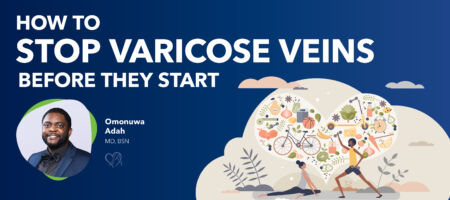
Medically reviewed by Omonuwa Adah, MD, BSN, on October 5, 2025
Varicose veins aren’t just a cosmetic issue. Those bulging, twisted veins you see under the skin are a sign that blood isn’t flowing properly through your legs. While they’re common, especially as we age, that doesn’t mean they’re inevitable.
The good news is that there are proven steps you can take to reduce your risk of varicose veins and keep your legs feeling healthy and strong. Read on to learn how.
The bad news is that not every case of varicose veins can be prevented due to factors beyond our control, including family history, pregnancy, and the natural aging process.
Still, by making small, consistent lifestyle changes, you can slow their development or keep them from forming.
For this blog, we consulted Dr. Omonuwa Adah, lead physician at Center for Vein Restoration in Hamilton, New Jersey.
📍 To schedule an appointment with Dr. Adah in Hamilton, NJ, CLICK HERE.
🚩To schedule an appointment at any of CVR’s 120+ vein clinics nationwide, or click below ⬇️

Your veins carry blood back to your heart, and tiny valves inside the veins keep the blood moving in the right direction. When those valves weaken or fail, blood pools in the vein instead of flowing upward. Over time, the vein becomes stretched, twisted, and visible under the skin, appearing as a varicose vein. This condition is known as chronic venous insufficiency (CVI).
According to the National Library of Medicine (NIH), several common risk factors increase the chances of developing varicose veins.
These include:
Because chronic venous insufficiency is progressive, it won’t improve on its own, and the longer it’s left untreated, the more likely it is to cause serious complications. The good news is that early intervention makes all the difference.
As the nation’s top vein care provider, CVR offers the widest range of FDA-approved treatments delivered by board-certified physicians you can trust. Schedule with America’s largest physician-led vein center today⬇️

To slow the progression of varicose veins before they develop, regular movement is essential. Exercise helps your calf muscles act like a “pump,” pushing blood back toward your heart.
If your job keeps you at a desk or on your feet all day, take short breaks every hour. Walk to get water, stretch your calves, or flex your ankles to encourage blood flow.
Carrying extra pounds puts unnecessary strain on your veins. Even a modest weight loss can reduce your risk of developing varicose veins and improve your overall vascular health.
CLICK HERE for a handy BMI calculator chart provided by the Cleveland Clinic.
Think of your plate as medicine for your veins. The choices you make every day can have a direct impact on how your legs feel years from now.
Gravity isn’t always your friend when it comes to vein health. That’s why elevating your legs can help. When your feet are raised above the level of your heart, blood flows back more easily.
Try resting with your legs on a pillow at the end of the day or after long periods of sitting. Small adjustments also matter:
Simple posture adjustments can go a long way toward keeping blood flowing.
Compression stockings aren’t just for people who already have varicose veins. They’re also an innovative preventive tool, especially if you’re at higher risk. These snug-fitting garments apply gentle pressure to your legs, helping veins and muscles move blood more efficiently.
Modern compression stockings are more comfortable and discreet than ever. They come in a variety of strengths, so it’s best to talk with a vein specialist about which option is right for you. If you stand or sit for long shifts at work, wearing compression can be one of the most effective ways to stop varicose veins from developing.
At Center for Vein Restoration, our board-certified vein specialists can help you determine whether compression therapy is right for you — and guide you toward the best options to protect your vein health. Schedule a consultation today and take the first step toward stronger, healthier legs.⬇️

Several daily habits can either support or sabotage your vein health.
Your lifestyle doesn’t need to be perfect, but consistent small changes add up over time!
Despite your best efforts at prevention, varicose veins may still form. That doesn’t mean you’re out of options. Today’s vein treatments are minimally invasive, performed in-office, and require little to no downtime. If you notice persistent leg swelling, heaviness, or visible bulging veins, it’s worth getting evaluated by a vein expert.
Catching vein problems early can prevent them from progressing to more serious conditions, such as skin damage or venous ulcers.
👉 Book your consultation with a CVR vein specialist today and discover how simple relief can be.
Varicose veins aren’t just part of getting older — they’re a sign of underlying circulation problems. While you can’t control every risk factor, you can make choices today that protect your legs for years to come. Staying active, eating a balanced diet, elevating your legs, and wearing compression stockings are all effective ways to maintain healthy veins.
If you’re worried about your veins, don’t wait until symptoms get worse. The board-certified vein specialists at Center for Vein Restoration are here to help with advanced diagnostics and treatments designed to restore healthy circulation. With more than 120 locations nationwide, expert care is always nearby.
📞 Call Center for Vein Restoration at 240-965-3915
📅 Or book online HERE